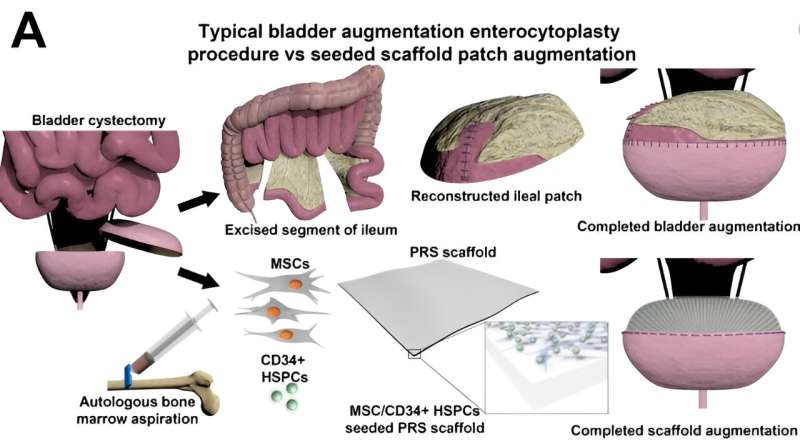This article has been reviewed according to Science X's editorial process and policies. Editors have highlighted the following attributes while ensuring the content's credibility:
fact-checked
peer-reviewed publication
trusted source
proofread
Research team achieves regeneration of functional bladder tissue using bone marrow cells

Scientists from Stanley Manne Children's Research Institute at Ann & Robert H. Lurie Children's Hospital of Chicago and Northwestern University have succeeded in regenerating fully functional urinary bladder tissue in a long-term study utilizing a non-human primate model.
This unique model initially created by the Sharma Research Group explores long term bladder tissue regeneration at both anatomical and physiological levels. The team used a novel biodegradable scaffold seeded with stem and progenitor cells from the animal's own bone marrow, which demonstrated a higher degree of success than intestinal segments that are traditionally used to treat different types of bladder dysfunction. The regenerated bladder tissue was healthy after two years of monitoring and serves as a pre-clinical model for humans.
The findings are published in PNAS Nexus.
"Our results were fantastic and point to a new direction in the field," said senior author Arun Sharma, Ph.D., Director of Pediatric Urological Regenerative Medicine at Manne Research Institute at Lurie Children's and Research Associate Professor of Urology at Northwestern University Feinberg School of Medicine. "The likelihood that our innovative platform will be feasible in humans is very high and we anticipate launching a clinical trial soon."
Patients with severe bladder dysfunction, who include a variety of adult and pediatric patients, have very limited options for bladder tissue replacement. Dr. Sharma and colleagues are targeting the pediatric spina bifida population with their bladder regeneration work.
It has taken them over a decade to reach this milestone, which bears strong potential for translation to clinical practice. Their aim is to offer a better alternative to current bladder augmentation surgery for severe bladder disease. Currently, small intestine tissue is used to replace dysfunctional bladder tissue, but that increases the risk of numerous clinical complications.
"Our innovative approach is promising to make a great difference in the lives of children with spina bifida and others with end stage bladder dysfunction," said Dr. Sharma. "Since we would be using the patient's own bone marrow cells, there are no concerns with rejection and our scaffold is non-toxic and biodegradable. In our study, the bladder started working within a few months and demonstrated functionality throughout the course of the study. This is a major advance that will transform clinical practice."
More information: Matthew I. Bury et al, Multipotent bone marrow cell-seeded polymeric composites drive long-term, definitive urinary bladder tissue regeneration, PNAS Nexus (2024). DOI: 10.1093/pnasnexus/pgae038



















